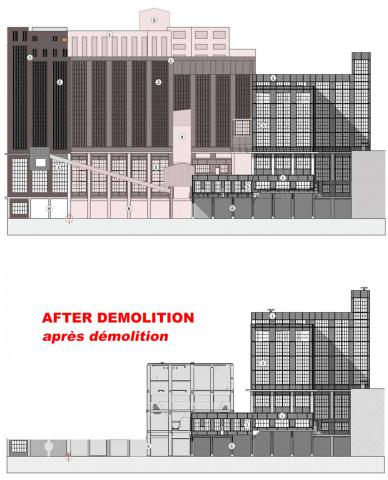Save the coal processing plant of the Beringen coalmine
Heritage can not defend itself. It needs assertive defenders
help to save this building, since 1994 protected monunument but now endangered
This huge coal preparation plant is part of the Beringen mining site, a large former coal mine in the Flemish province of Limburg (Belgium). The coal mine is an important example of the large-scale developments in coal extraction in Europe and the rest of the world in the 20th century.
The construction of this large coal preparation plant started in 1923-1924 (coal preparation plant 1) and this first part was later expanded with coal washers 2,3 and 4. The four parts together form one massive building in iron, steel, brick and glass, which not only dominates the mine site but also the surrounding area.
The entire coal mine of Beringen, including the four parts of the coal preparation plant, was legally protected as a monument by the Flemish Government in 1993 and 1994.
In 2009, the redevelopment of the mine was assigned to PPP company, with the main partner being LRM for 50% (the Limburg Reconversion Company - a company set up and controlled by the Flemish Government) together with a number of construction and real estate companies. They concluded that the maintenance of the complete coal preparation plant would not be possible and decided - without a thorough study of the building history - on the imminent demolition of coal preparation plants 1 and 3. On the site of coal preparation plant I a car parking would be developed.
One of the arguements for the demolition are the costs of maintenance and the lack of subsidies. However, the Flemish Government being 100% owner of LRM, this means that subsidizing the PPS company BE-Mine means that the Flemish Government is subsidizing itself for at least 50%.
Being aware of the danger a dossier of the coal preparation plant of Beringen was sent in for the 2018 'The 7 Most Endangered' programme. This is a campaign of Europa Nostra, the leading heritage organization in Europe, the European Investment Bank Institute, supported by the Creative Culture program of the European Commission. On January 16th it was announced that the coal preparation plant at the Beringen coal mine was selected by an international panel of experts to be one of the 12 heritage sites on the shortlist - and thus was considered one of the most endangered and most important heritage sites in Europe.
Just before the summer break of 2017, the PPS company BE-Mine had applied for a demolition permit for coal preparation plant n° 1. It was also announced that once this coal preparation plant n°1 had been demolished, the procedure to demolish plant n° 3 would be started. While the plant was mentioned as one ofthe 12 most important endangered sites, withouth the legal protection of the building being lifted, a demolishing permit was granted in mid March 2018.
This was illegal.
After a procedure filed by the Flemish Association for Industrial Archeology, together with local associations, the permit was suspended by the Court.
In order to circumvent this ruling, the strategy now is is to remove at first the protected status, and then grant a demolishing permit again and as soon as possible.
The demolition of a large part of this legally protected building ignores the importance of the integrity of a historic building. The demolition of the first part could create a dangerous precedent for further damage and destruction, leading to the loss of the value of the entire plant. It will also create a dangerous precedent for other protected buildings in Flanders, if one is permitted to demolish part of a historic monument without obeying to the legally prescribed procedures.
The Flemish Advisory Commission for the Architectural Heritage (‘Vlaamse Commissie Onroerend Erfgoed) formulated last year in September a strong and well motivated negative advise for lifting the protection of the building. However, apparently this is not taken into consideration by the Minister in charge, who started mid December the procedure to unprotect the coal preparation plant.
For the lifting of a protection, according to the Flemish historic buildings legislation, a public inquiry is required. Every citizen and association, without any restriction, from Flanders or abroad - can file a notice of objection and indicate that he / she is opposed to the abolition of the protection and against the demolition of parts of the coal washing plant of Beringen.
Such a notice of objection is a letter in which you:
1. announce that you opposed to lifting the protection and demolition of the building.
2. the reason why.
The reasons may be personal: why do you think that this building should continue to exist? But you must always state that you object to the removal of the protection of this building and knocking it down.
Other reasons can be eg:
- that the removal of the protection is a wrong signal as far as other protected buildings are concerned. It is a dangerous precedent, because it opens a door for removing the heritage protection of other monuments under the guise that preservation would be 'too expensive'. What is 'too expensive'? This removes the legal certainty of protected monuments
- the coal preparation plant at Beringen is one of the last of these in Europe, the last in Flanders. Being one of the last major coal processing plants in Europe, it is an important European witness of large-scale mining from the beginning of the 20th century. It is the dominant complex from which one can derive the scale of coal production in the coalmine of Beringen and the development of modern mining since the early 1900s
- it is unacceptable for a Minister to disregard the reasoned opinions of his official heritage advisory committee and also of a court (see above) when deciding to lift the heitage protection of a building. The coal mine was protected (scheduled) as a historic monument in 1993 by the Flemish Government, the coal preparation plant in 1994.
- that the coal preparation plant is the most dominant building of the protected coal mine due to its volume, and that the integrity of the protected site will seriously be affected by its demolition
- demolishing large part of the coal washing plant will cause serious harm to the value and integrity of the protected coal mine of Beringen. The coal washing complex is one of the last of such plants in Europe, and the coal mine of Beringen is one of the rare large mines that have been protected completely.
- the lack of money should not be used as an alibi to remove the legal protection of a historic building
- one should carefully, and via a international task force, study the problems and find good solutions for the conservation and adaptive re-use of this unique building
- de-listing and demolishing will cause serious damage to the international image of Flanders' heritage policy. Flanders will expose itself to international criticism, which will greatly damage its prestige of a region with and caring for a rich heritage
- the selection of the coal preparation plant for the shortlist of 'The 7 Most Endangered' proves its importance and uniqueness in a European perspective. An international team of experts should be allowed to study the site and make proposals for its conservation and adaptive re-use
- The coal preparation plant at Beringen, a monument on a European scale, but with a very specific problem of preservation and redevelopment, requires a thorough approach using experience and expertise on a broad European scale. Because no expert working group or task force, including foreign experts, were involved in research and evaluation, numerous opportunities remained unused. This lay at the basis of rather incompetent advices from heritage services and local architects, who are not used to and also have insufficient experience to deal with this set of scale and problems.
- The coal-washing plant would be demolished without a vision being formulated on what would happen to its space. According to the illustrations that were disseminated by the developer, only a parking lot would be laid on the site of the demolished sections - and it is also admitted that there are no other or specific destinations for the broken-open space. It is at present socially totally irresponsible to abolish a heritage protection and thereby allow demolishing a heritage building, without a clear view on the future or re-use of the site.
- An alleged 'bad state' of a monument should never be a reason to abolish its protection to allow a subsequent demolition. In an architecture report from the end of 2003, the situation was still called 'acceptable', but it was also advised to carry out a number of interventions to prevent vandalism and to keep the building and its parts wind and water-free. The owner or holder of rights is bound by a maintenance obligation according to the Flemish Immovable Heritage Decree. This not being done for a quarter of a century, the abolition of the protection and the granting of demolishment would de facto be a remuneration of a violation of the legislation. It would be a precedent and stimulate other owners to try and do the same thing.
- etc...
These letters must be sent by registered mail to;
City council of Beringen
Stadsbestuur Beringen, dienst Wonen.
T.a.v. openbaar onderzoek kolenwasserij
Mijnschoolstraat 88
B-3580 Beringen
Flanders - Belgium
They must arrive before March 19th at the latest. Taking into consideration that a registered letter from an other country to Belgium may take five working days, drop your letter at the post office before March 12th !!!!
|
If you are afraid your letter won't arrive in due time, then add the following sentence in handwriting I hereby give power of attorney to the Flemish Industrial Archeology Association and the Beringen Heritage Association to issue this letter against receipt, and in my name, to the city of Beringen, to be included in the file of the public consultation Date and sign it Scan this document and send it as a PDF to <erna.aerts@beringen.be> at the Beringen city council, and in cc.: to the Limburg chapter of the Flemish Association for Industrial Archaeology <limburg@vvia.be> and the Beringen Heritage Association via <stephan.put1@telenet.be> |
HELP US TO SAVE THIS BUILDING BY SENDING A LETTER TO THE CITY COUNCIL OF BERINGEN !!!
| The ‘Vlaamse Vereniging voor Industriële Archeologie’ (VVIA, Flemish Association for Industrial Archeology), the platform of private associations and volunteers committedbto the preservation, interpretation and presentation of industrial heritage in Flanders and Brussels fully supports the campaigns to save this extremely important building. |








